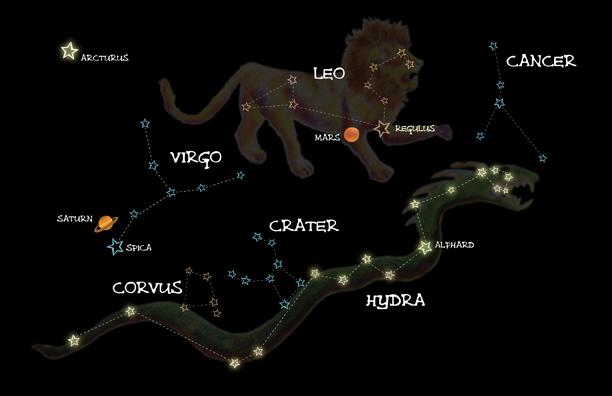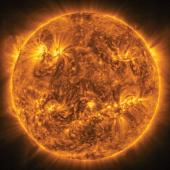Snakes on a Plain
As the world begins to sprout and bloom, the days and nights are better for strolling—but watch your step, for rattlesnakes and other wriggly reptiles are emerging from their lairs to sun themselves into activity once again. And they have plenty of cousins in the sky.
Foremost, if faintish, is Hydra, the great water snake that slithers along the south in the spring night sky. The largest of all the constellations, it coils around a quarter of the celestial sphere. But like its Earthly counterparts, this serpent can be hard to see and requires a good eye.
Start by looking for Leo the lion, high south in the spring evening sky. It lies nearly overhead, across the zenith (the overhead point) from the Big Dipper, which lies high north. The sickle shape of stars with the triangle to its left mark the pattern, the sickle forming Leo’s head and front, the triangle his hind quarters with its twitching tail. Now locate the bright star at the bottom of the sickle: Regulus, the heart of the lion. Then trace downward toward the horizon from Regulus and you’ll spy a star a little fainter, bearing a ruddy glow. That’s Alphard, another heart star—in this case, the heart of Hydra.
Follow up and right through a few faint stars to a tight oblong pattern, and you’ve found Hydra’s head. Then follow more faint stars in a meandering line down and east (left) of Alphard, underneath the Y-shape of Virgo and the small boxy shape of Corvus the crow, and you’re following the snake’s body until it disappears below the southeastern horizon.
Leo and Hydra share something in common: they’re both victims of Hercules (or Heracles to the Greeks), dispatched during his mythical Twelve Labors. Leo, portraying the Nemean lion, was a nasty fellow and was squeezed to death by the strongman, stripped of his pelt, and tossed into the sky. Hydra was perhaps even nastier: a nine-headed monster with poisonous breath, the center head immortal, issuing regularly from a gurgling swamp to lay waste to the countryside.
Hercules stepped in to handle the problem but discovered that every time he lopped off one of the Hydra’s heads, two more grew back in its place—and he was getting nowhere. In exasperation, he enlisted his sidekick Iolaus to swing a flaming torch with each beheading to cauterize the wound, this action preventing any more head growth. Hercules sliced off the immortal head last of all, and he was on to his next labor. Today, Hydra snakes across the sky, but with just the one head—presumably the immortal one.
Another myth links it with Corvus, riding on its back. It seems some delectable figs delayed the naughty crow while fetching water for a thirsty Apollo. The god punished the bird by turning its white feathers black, turning its sweet voice into a raspy caw, and putting it in the sky near his water cup (the faint constellation Crater) but just out of reach. The water snake guards the cup, so now it’s Corvus who’s thirsty.
Remaining just out of reach of the water snake are this year’s spring planets, sidling up to the season’s bright stars from our Earthly perspective. Look for red Mars a little left of Regulus, Leo’s heart star, in April and May, and you can spy Saturn passing slowly above Spica, the anchor star of Virgo’s Y-pattern, at the same time. Moving carefully, they will avoid drawing Hydra’s ravenous attention.
Hydra is not the lone representative of its kin up there, however; the place is crawling with them. Wait a little while until the summer pattern of Scorpius the scorpion rises later in the night. Look above it at the coffin-shaped outline of Ophiuchus and you’ll find him struggling with Serpens the serpent; he clasps the snake by its middle, and it wriggles out on either side. Finally there’s Hydrus, a southern hemisphere and even fainter counterpart to Hydra, one of the nondescript modern constellations winding around the south celestial pole.
It’s truly “snakes on a plain”—the glittering plain of the night sky wheeling overhead, reminding us to watch our step on every clear night of spring!
Jim Manning is currently executive director of the Astronomical Society of the Pacific in San Francisco, but lived outside Bozeman for many years and visits regularly.












